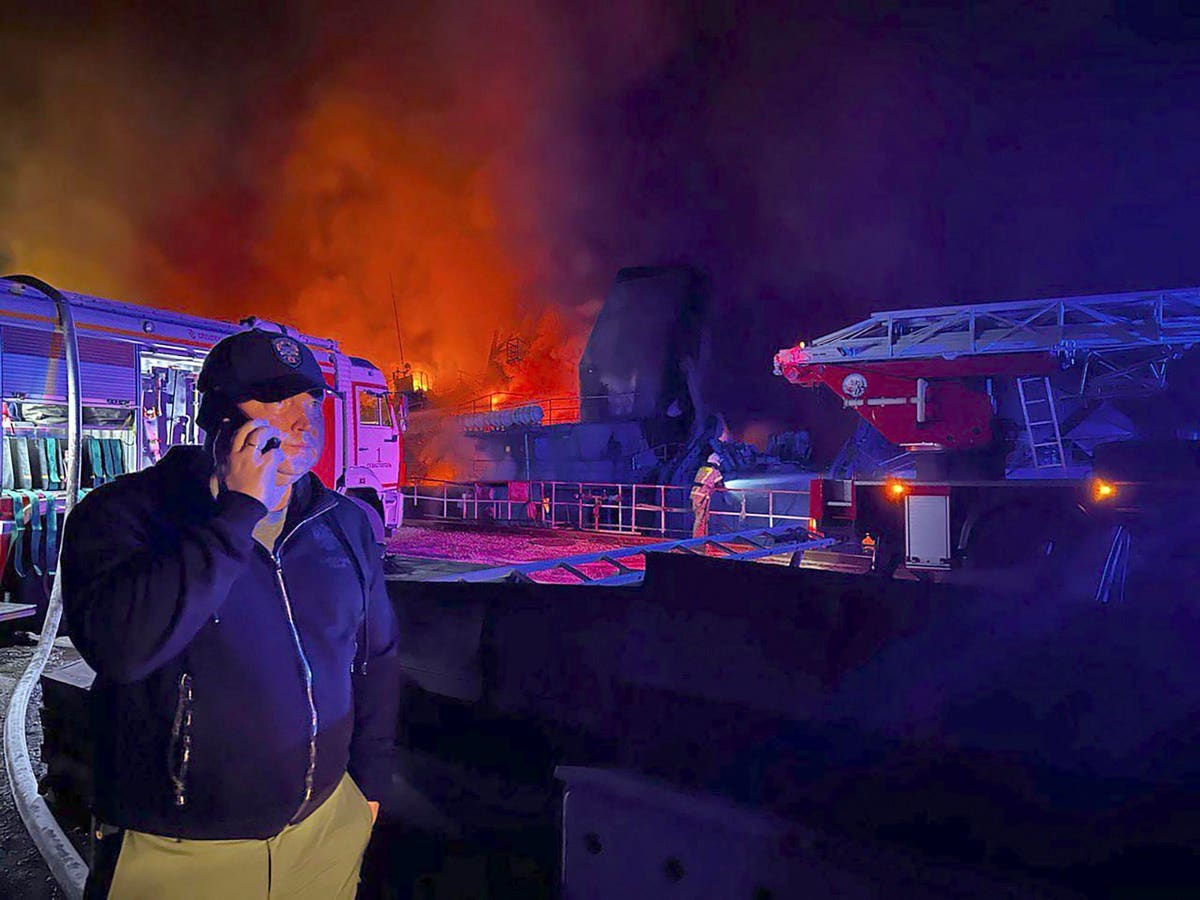Ukraine’s audacious strike on Sevastopol’s naval infrastructure has apparently severely damaged a landing craft and a submarine. Aside from inflicting significant naval losses, the sidelining of a major naval dry dock facility complicates Russia’s ability to operate on the Black Sea.
In modern warfare, dry docks have always been a high-priority target.
As complex pieces of heavy machinery, necessary for the basic maintenance of any naval force, dry docks—facilities where ships be floated in and repaired after water is pumped out—are not easy things to fix. America is spending billions to refresh undamaged dry docks. Repairing battle damage will be far more costly.
Russia’s inability to defend these vital pieces of critical military infrastructure is a stunning military failure, suggesting Russia’s air defenses are either inadequate, broken or both.
But the strike also highlights Russia’s desperation. After several strikes across Crimea and Sebastopol, Russia knew the docks were likely targets, but, regardless of the threat, Russia continued to use them to maintain key Black Sea naval units.
Russia had nowhere else to go.
Russia’s lack of modern Black Sea waterfront repair infrastructure is a serious problem for Russia’s Black Sea fleet. Without maintenance support, Russia’s entire Black Sea Fleet will, in a matter of months, be operationally ineffective—and effectively sunk.
Russia Ignored World War II Lessons:
In World War II, Allied forces put enormous resources into disabling key pieces of naval infrastructure. To neutralize the threat from the newly-constructed Tirpitz, a formidable German battleship, England put an enormous amount of resources into knocking out a large dry dock in the French port of St. Nazaire—the only dry dock outside of Germany able to repair the big German warship.
To destroy the facility, England fought their way to the dry dock, rammed it with an explosives-filled destroyer, and blew it up. It was a costly venture. Of the 612 men who participated in the raid, only 228 returned. 169 men were killed and 215 were taken prisoner.
But the dry dock was destroyed. It didn’t go back into service until 1950—five years after the war ended.
While the 990 lb warhead on a Storm Shadow cruise missile cannot match the explosive power of the 4 tons of explosives used to blow up the St. Nazaire docks, reports suggest Ukraine dedicated up to ten of these precision-strike missiles to the attack.
Aside from hitting the warships inside the dry docks, it would have been easy to dedicate a missile or two to a critical dry dock pump house or to the dry dock doors, themselves, further complicating any attempt to bring these irreplacable facilities back to service.
Russia has other dry docks available at the far-away Port of Novorossiysk, in Russian territory. But the dry docks in Novorossiysk are floating dry docks, and, by design, they are far less capable of efficient handling of battle damage or major refits.
With Sebastopol now undeniably in the line of fire, analysts and open-source researchers should anticipate some rather frantic Russian efforts either break Turkey’s hold on military transits through the Straits of the Dardanelles and the Bosphorus, or to build a graving dock or other permanent dry dock structure somewhere on Russia’s Black Sea coastline.
Russia’s Black Sea Fleet Is In Big, Big Trouble:
Russia’s inability to manage air defense has allowed Ukraine another chance to nibble away at Russia’s forces on the Black Sea. And Russia should know that naval ships, while undergoing deep maintenance, are tremendously vulnerable.
The U.S. loss of the $1.2 billion amphibious assault ship USS Bonhomme Richard (LHD 6) in 2020 demonstrated the challenge of fighting fires onboard a ship under maintenance. With the crew absent, lots of flammable materials and, often, lines strung so the ship cannot isolate fires to one section, a yard fire is one of the toughest conflagrations to fight.
The targets are particularly interesting.
With the apparent loss of the second Ropucha-class landing ship in as many months, Russia is steadily losing the capability to move supplies and gear across the Azov Sea and into a potentially cut-off Crimea.
Ukraine may well be targeting these logistical support craft. Russia has a few old Alligator (Project 1171) class LSTs, several Ropucha (Type 775) class LSTs , and one Ivan Gren (Design 11711) class LST in the Black Sea. The ships, in themselves, are land-attack threats—in the run-up to war, Baltic states panicked as six of the modest-sized landing craft sailed for the Black Sea.
With each Ropucha able to carry up land ten main battle tanks and some 340 troops, these transport ships—when they are not sidelined due to a lack of spare parts—will be critical assets if Crimea is cut off later this year.
The potential loss of the Rostov-on-Don, a Project 636.3 diesel submarine is particularly interesting. Russia’s Black Sea submarine fleet are Russia’s primary maritime threat. As unseen attackers, they can sink cargo ships, fire Kalibr land-attack missiles, conduct surveillance or land commandos.
Barely ten years old, the Rostov-on-Don is a relatively modern Kilo-class submarine. The loss will sting, but it’s only a hint at what is to come as Russia’s Black Sea fleet, starved of maintenance support, cedes waters coveted by Russia to Ukraine, Georgia, Turkey and other NATO stakeholders.
Read the full article here





